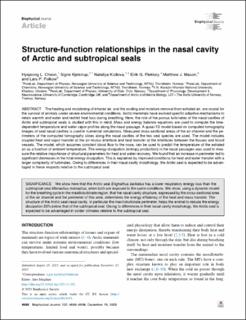| dc.contributor.author | Cheon, Hyejeong | |
| dc.contributor.author | Kjelstrup, Signe | |
| dc.contributor.author | Kizilova, Nataliya | |
| dc.contributor.author | Flekkøy, Eirik Grude | |
| dc.contributor.author | Mason, Matthew J. | |
| dc.contributor.author | Folkow, Lars | |
| dc.date.accessioned | 2024-01-12T08:07:40Z | |
| dc.date.available | 2024-01-12T08:07:40Z | |
| dc.date.created | 2024-01-05T11:03:52Z | |
| dc.date.issued | 2023 | |
| dc.identifier.citation | Biophysical Journal. 2023, 122 (24), 4686-4698. | en_US |
| dc.identifier.issn | 0006-3495 | |
| dc.identifier.uri | https://hdl.handle.net/11250/3111232 | |
| dc.description.abstract | The heating and moistening of inhaled air, and the cooling and moisture removal from exhaled air, are crucial for the survival of animals under severe environmental conditions. Arctic mammals have evolved specific adaptive mechanisms to retain warmth and water and restrict heat loss during breathing. Here, the role of the porous turbinates of the nasal cavities of Arctic and subtropical seals is studied with this in mind. Mass and energy balance equations are used to compute the time-dependent temperature and water vapor profiles along the nasal passage. A quasi-1D model based on computed tomography images of seal nasal cavities is used in numerical simulations. Measured cross-sectional areas of the air channel and the perimeters of the computed tomography slices along the nasal cavities of the two seal species are used. The model includes coupled heat and vapor transfer at the air-mucus interface and heat transfer at the interfaces between the tissues and blood vessels. The model, which assumes constant blood flow to the nose, can be used to predict the temperature of the exhaled air as a function of ambient temperature. The energy dissipation (entropy production) in the nasal passages was used to measure the relative importance of structural parameters for heat and water recovery. We found that an increase in perimeter led to significant decreases in the total energy dissipation. This is explained by improved conditions for heat and water transfer with a larger complexity of turbinates. Owing to differences in their nasal cavity morphology, the Arctic seal is expected to be advantaged in these respects relative to the subtropical seal. | en_US |
| dc.language.iso | eng | en_US |
| dc.publisher | Elsevier | en_US |
| dc.rights | Navngivelse 4.0 Internasjonal | * |
| dc.rights.uri | http://creativecommons.org/licenses/by/4.0/deed.no | * |
| dc.title | Structure-function relationships in the nasal cavity of Arctic and subtropical seals | en_US |
| dc.title.alternative | Structure-function relationships in the nasal cavity of Arctic and subtropical seals | en_US |
| dc.type | Peer reviewed | en_US |
| dc.type | Journal article | en_US |
| dc.description.version | publishedVersion | en_US |
| dc.source.pagenumber | 4686-4698 | en_US |
| dc.source.volume | 122 | en_US |
| dc.source.journal | Biophysical Journal | en_US |
| dc.source.issue | 24 | en_US |
| dc.identifier.doi | 10.1016/j.bpj.2023.11.012 | |
| dc.identifier.cristin | 2221243 | |
| cristin.ispublished | true | |
| cristin.fulltext | original | |
| cristin.qualitycode | 1 | |

